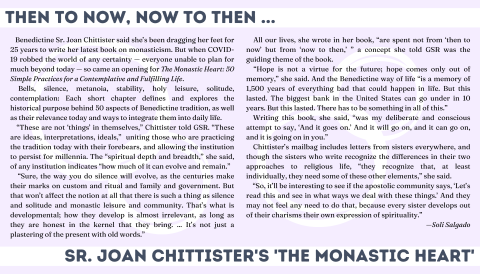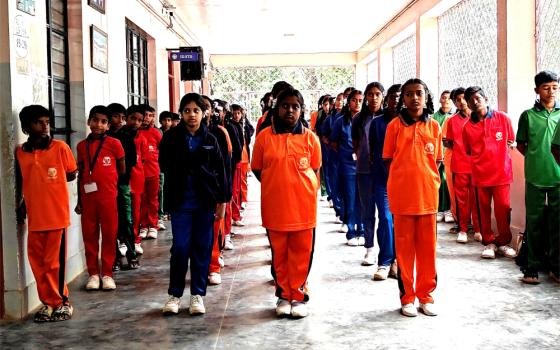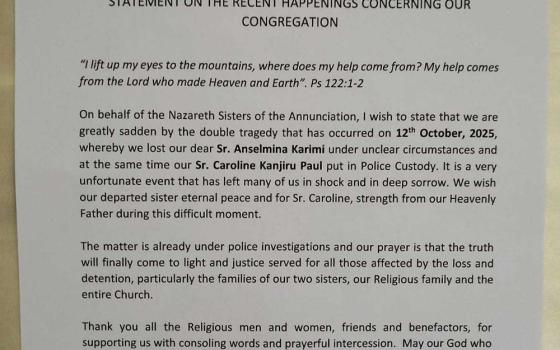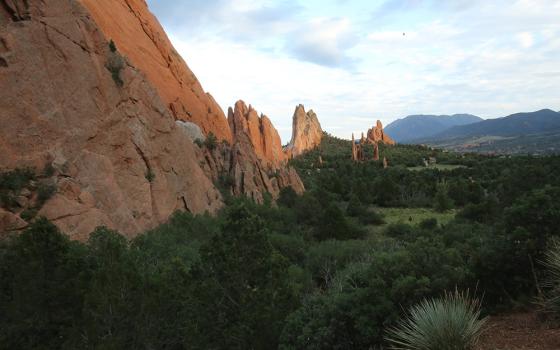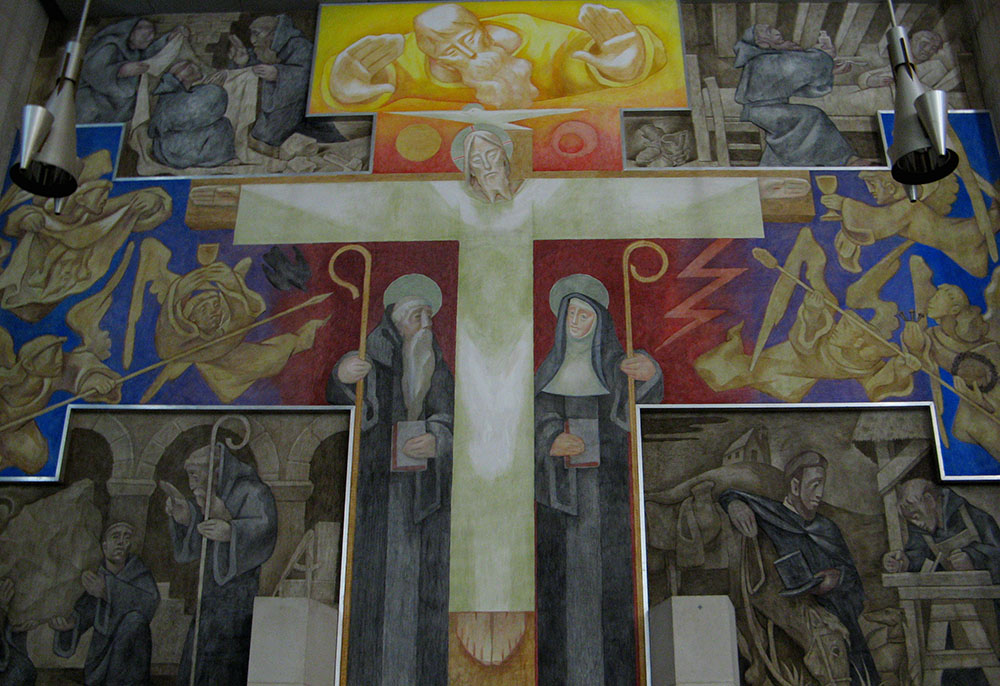
A fresco with scenes from the life of St. Benedict of Nursia, at St. Benedict's Abbey in Atchison, Kansas (Flickr/Randy Greve)
When Judith Valente, a Benedictine oblate, leads contemplative retreats both online and in monasteries around the country, she's been noticing that laypeople — whether Catholic or spiritual-but-not-religious, married or unmarried, male or female — outnumber the monks and sisters about three to one.
"And why is this?" said Valente, who is an author and co-chair of the movement Being Benedictine in the 21st Century. "There's a hunger out there for genuine communion. Not just communication, but genuine communion, and one of the biggest monastic values is hospitality. Here, they suddenly feel valued, like they belong here."
Drawing parallels between today and the time of St. Benedict of Nursia, Valente doesn't think the renewed interest in monasticism over the past several years is a fluke, either.
The father of Western monasticism, Benedict wrote the Rule (a document that would ultimately serve as the foundation of his monastic tradition) in the sixth century during the collapse of the Roman Empire, Barbarian invasions, loss of institutional credibility, and political leaders prioritizing personal interests over the common good.
"He lived in a time that sounds a lot like our nightly news," said Valente, who is an oblate with the Benedictine Sisters of Mount St. Scholastica in Atchison, Kansas.
Monastic traditions — including stability, silence, community, hospitality, love of learning, and continual growth, to name a few — are speaking to this moment, and those ranging from the nonreligious to apostolic Catholic sisters are listening.
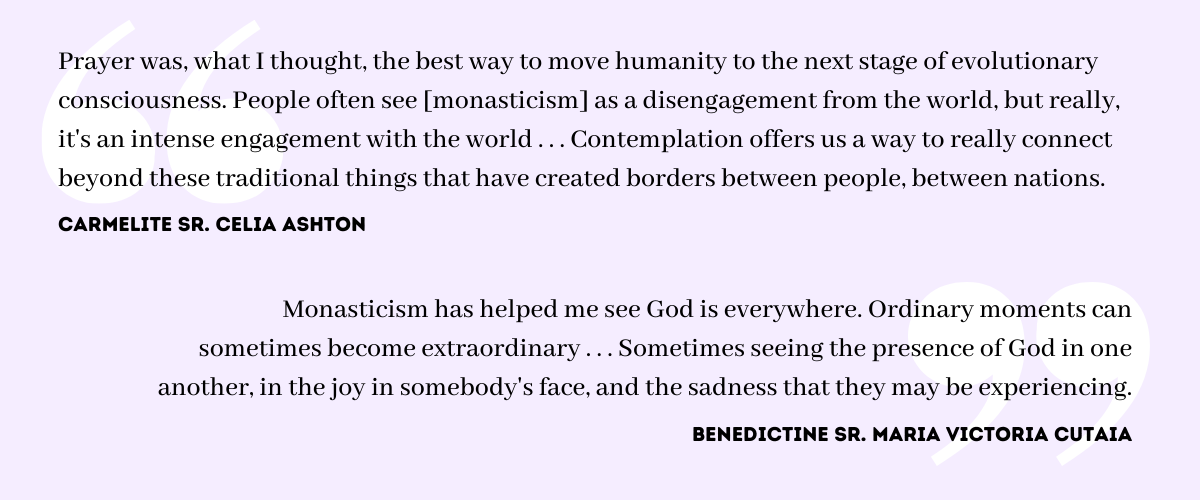
In the last few years especially, Catholic sisters in apostolic communities — which tend to lead a more mobile and ministerial lifestyle with less structure than their monastic counterparts — have been reengaging with the communal contemplative dimension of religious life. (In 2017, the Leadership Conference of Women Religious, which represents 80% of U.S. sisters, honored Baltimore Carmelite Sr. Constance Fitzgerald, a contemplative scholar, with its Outstanding Leadership Award, illustrating the renewed emphasis on silent, meaningful reflection.)
The Second Vatican Council lit a fuse for religious congregations in the early 1960s: Suddenly, sisters were encouraged to return to their founding visions through their action-oriented ministries, modeling the life of Jesus with their community's charisms at the center of their calls to action. But as needs shift, so do the ways that religious communities respond, and today, many feel called to focus on society's growing spiritual hunger and to reclaim the value of collective contemplation.
"There's a great interest in bringing back together the two sides of a coin — contemplation and action in new ways — especially through apostolic religious," said Sr. Nancy Sylvester, whose Immaculate Heart of Mary congregation in Monroe, Michigan, is apostolic. Indeed, many apostolic congregations today, such as the Ursulines, refer to their charisms as "contemplation in action."
"It's an evolutionary process," she said, noting that the roughly 60 years of the pendulum swing toward activism is "not a lot in evolutionary time," but enough to consider a "new integration" for a future that is still emerging.
Advertisement
Asking why there is a renewed interest in monasticism lends itself to an idle exercise in speculation: To say that monasticism is experiencing a "comeback" is to misunderstand the tradition, as Benedictine Sr. Linda Romey explains it.
Monasticism, rather, is experienced as an "evolution, a moving forward," with no going back, said Romey, a member of the Benedictines of Erie, Pennsylvania.
"If monasticism is a doorway to a more contemplative life, that means it is a doorway to the future, to a deeper knowledge of what it is to be a human creature made in the image of God."
'Living otherwise'
Fr. Adam Bucko, an Episcopal priest, isn't convinced that humanity today is going through a "process of secularization," or that there is even a meaningful distinction between the secular and the sacred.
"They're telling us the tabernacle is empty," he said, yet "many people who identify as not religious, actually, are not in churches because they found God elsewhere: in nature, in activism, in joining people who are fighting for justice, in what could be called less religious spiritualities, like mindfulness."
Bucko is the co-founder of the Center for Spiritual Imagination, a new monastic community that weaves Benedictine, Franciscan, Cistercian and Carmelite traditions with other spiritual influences. He believes that how someone feels about churches isn't a predictor for how they feel about God, spirituality or the mystical quest for meaning and purpose.
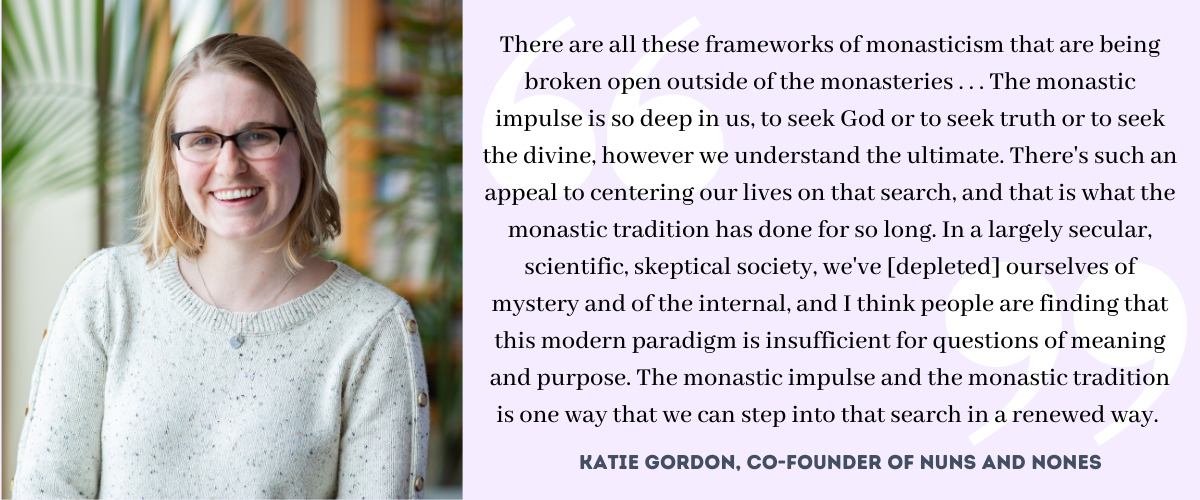
Statistics bear that out. A third of young people are religiously unaffiliated — three times the rate of their grandparents' generation. But tucked away in that statistic is a crucial though less-touted detail: Among those who are nonreligious, about two-thirds say they still believe in God to varying degrees.
Movements like Nuns and Nones, a grassroots community uniting Catholic sisters and young spiritual seekers, have provided space for spiritually ambiguous conversations among those interested in exploring the contemplative as well as the communal.
Perhaps it's natural that monasteries have since become a home for some of its members.
For the past two years, Katie Gordon, co-founder of Nuns and Nones, has been living with the Benedictine Sisters in Erie. What began as a summer internship morphed into the decision to live indefinitely in the monastery's Pax Priory community.
Seeing firsthand how the Benedictines live their life in search for God in a "generative, open way" made Gordon want to stick around and learn more about their 1,500-year-old lifestyle, the community model for "living otherwise."
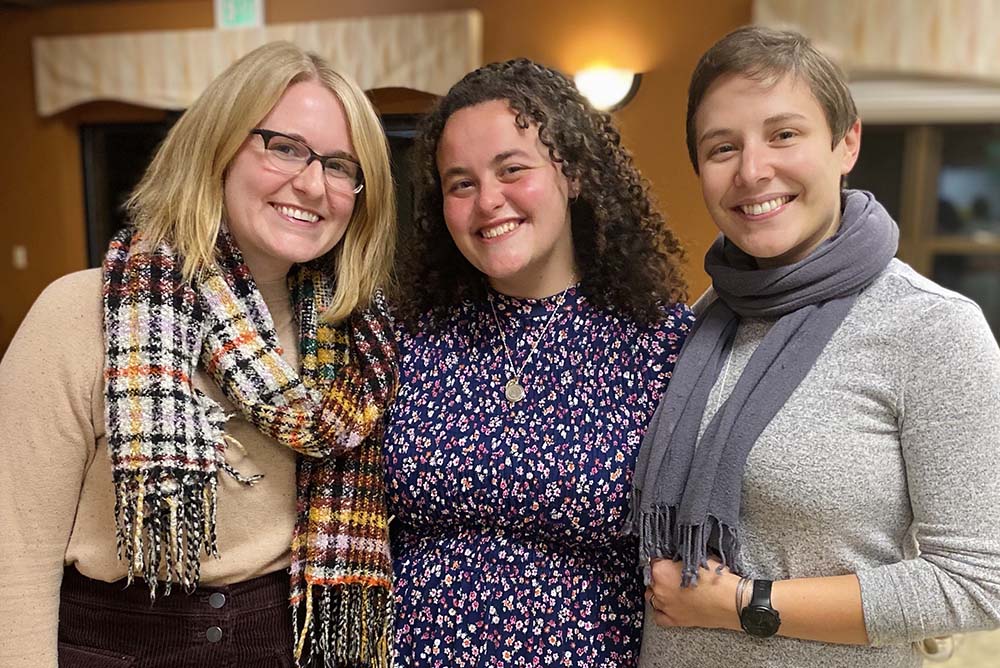
From left: Katie Gordon and Benedictine Srs. Jacqueline Sanchez-Small and Val Luckey, at Sanchez-Small's first profession ceremony with the Benedictine community of Erie, Pennsylvania, in November (Courtesy of Katie Gordon)
Gordon, 30, grew up Catholic but spent most of her 20s on a spiritual expedition, focusing less on pinning down the specifics of her beliefs and more on drawing inspiration, meaning and mystical nourishment from a variety of religious traditions. She has spent the last several years particularly immersed in the world of contemplative women religious.
"This is a huge moment of upheaval that we will be moving through, and this alternative way of being provides a community model to move through that," she said regarding this time in history.
Though the word monasticism often conjures images of extreme religiosity — likely of reclusive individuals immersed in Scripture — the concept is much more expansive.
"Monasticism is a lifestyle word, not a religion word," said Benedictine Sr. Judith Sutera from Atchison, Kansas. "It's an attempt to see unity in all of creation."
Benedictine Sr. Joan Chittister, a theologian and author, recalls the frustrations she'd feel as a child when the big questions around God would arise, and the unsatisfying answers that would follow to simply have faith, despite finding it all unbelievable.
"We do not, by and large as a culture, have a God big enough to believe in," she told Global Sisters Report. "We have diminished God. We've made God a puppeteer, a magician, a vending machine, a warrior, a judge, all slivers of ourselves. But, of course, anybody with an understanding [looks] up in the sky at night, saying to themselves, what is out there? Where did this all come from? Where is it going? And what about the people who have left our lives? Where are they? Those are cosmic questions. And I believe that, for me, my God is a cosmic God."
Monasticism — which Chittister defines in her most recent book, The Monastic Heart, as "the single-hearted search for what matters" in any and every life — appeals to those questions and the exploration of a God who "is not a drawing of our own lives," she told GSR.
"Do I think this [practice] has to be Christian or Catholic? Absolutely not."
Even after more than two years living with Chittister's community, Gordon said that examining her beliefs is not where she pours her energy when regarding her spiritual or religious identity. She's come to understand spirituality as more of an "embodied experience, not a rational experience."
"There's enough room in the practices for me to show up and cultivate a consciousness of the Divine, however I understand it — even if I don't know what I believe, even if I am a bit spiritually agnostic or skeptical still," she said, adding that she finds common ground with the Benedictine focus on "creation spirituality," a theology determined to find God in all of life.
Bucko, who is also a co-author of The New Monasticism: An Interspiritual Manifesto for Contemplative Living, said he sometimes sees monastic communities asking themselves how they can be relevant in the world, wondering what they can offer young people who are longing for a spirituality that is not necessarily Christian.
"This is the time for those who feel called to traditional monastic or apostolic life to really reevaluate their roots, reacquaint themselves with the gifts that their different traditions offer them and to try to embody that, trusting that somehow it will be useful for what is to come," he said.
"What we need now are spiritual masters, spiritual guides, communities where we can go and see what a transformed life looks like. We need this more than ever, certainly in my lifetime."
Valente argues that "fluidity" in monastic life, wherein lifetime commitments aren't the expectation for all interested in participating, is worth considering within monastic communities. (As an oblate, Valente has vowed to live the monastic values as a secular associate of the Benedictines.)
Pointing to other traditions, Valente notes that one can be a Buddhist monk for three or five years before moving on with life — similar to what Gordon is doing with the Erie Benedictines. "And what's the worst that can happen? You take those monastic values of listening, community, hospitality, simplicity out into the world with you."
Reclaiming the monastic
Sutera, who has a master's degree in monastic studies, recalled a colloquium that gathered representatives from a range of religious communities circa 1990. It struck her then that when sisters in apostolic communities introduced themselves and their congregations, they noted they were founded "as a reaction against monastic life."
They meant a life of enclosure, cut off from the world and obligated to lengthy periods of prayer — qualities that indeed described the "constricted" monasticism of centuries ago, Sutera said.
But "it was clear to us that they didn't really understand what monasticism was," because those were merely characteristics of the era, a time when both church and culture constricted the role of women, she said. So emerged apostolic communities (Franciscans and Dominicans being among the first), intent on leaving the monastery's walls to serve the poor, open schools and follow the model of Jesus.
Monastic communities, however, "weren't started to do things; we were started to be something," Sutera said. "That's what people are hungry to recapture now, because we are so far from a contemplative quiet, or a place of sacredness, or communities that are loyal for life, or any kind of permanent commitment to anything."
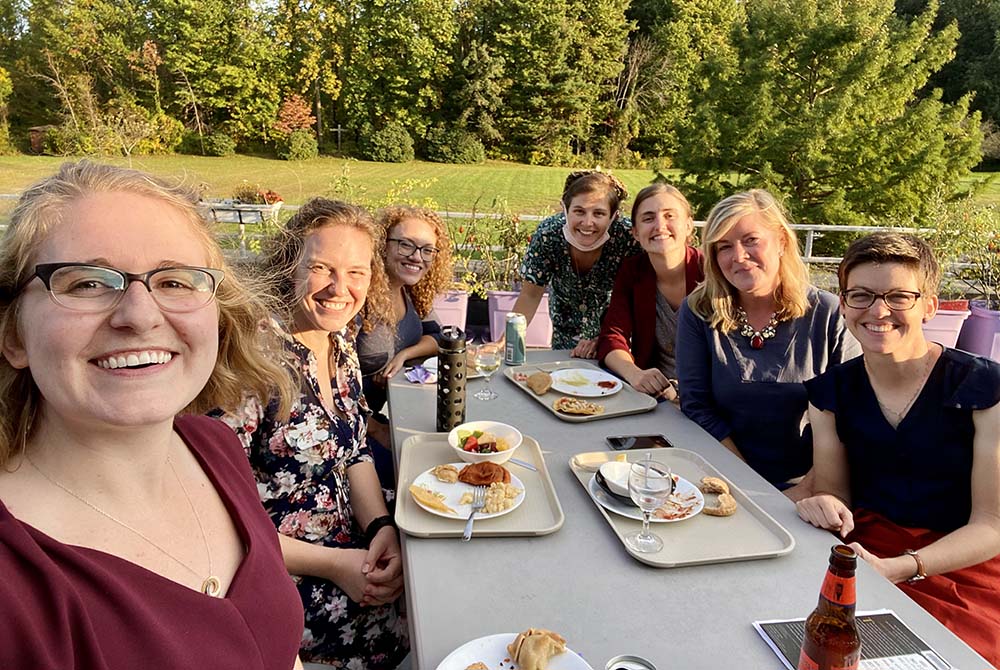
Benedictine friends in Erie, Pennsylvania, celebrate Sr. Val Luckey's perpetual profession ceremony in October. (Courtesy of Katie Gordon)
Sylvester, who is also the founder and director of the Institute for Communal Contemplation and Dialogue, said that recapturing "a sense of meaning as to why we're here" will require more than merely reverting to scouring the Baltimore Catechism, as was the case when she was growing up, she said.
"Women religious are seeing that hunger and believe — this sort of instinct — that we have something there to offer. And we're all still struggling to figure out how and what shape does it take, what container would hold this new consciousness? We're at the edge of the evolutionary journey at this point."
For many monastic sisters, like Benedictine Sr. Idelle Badt, silence is one of the tradition's greatest offerings, allowing her to "unplug from the world" when she returns to her Annunciation Monastery in Bismarck, North Dakota.
"I don't have the constant bombardment of white noise," said the 45-year-old sister, adding that it wasn't until she experienced shared silence in community that she realized how necessary silence is. "There is something magical when you sit in complete silence with 40 other people; your thoughts change, your body relaxes, and you feel closer to God and those around you."
Escaping constant chatter and cross-talk is particularly appealing to the younger members of Sr. Megan McElroy's Dominican congregation in Grand Rapids, Michigan, she believes. McElroy, who served as co-director of her community's novitiate 2010-18, also spent three weeks in an immersion experience with the Dominican contemplative community in Squamish, British Columbia, in 2016, working on her thesis project regarding the preaching missions of Dominican nuns who live a contemplative, monastic life.
In the novitiate, she heard from younger members a desire to incorporate more monastic traditions, such as silence, into the program.
"All the noise out there that we encounter in our daily lives makes us deaf to the voice of God," she said, referencing imagery from the book Sabbath by Wayne Muller. "I think what newer members are looking for is that space, the monastic space, so to speak, in an apostolic light that allows them to listen to how God is calling us to respond to what the world is crying out for."
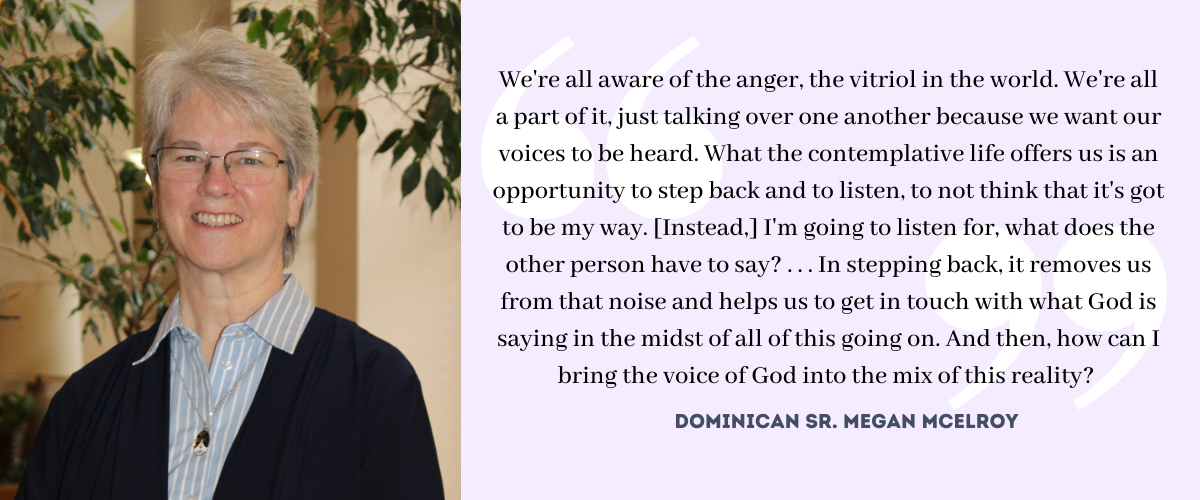
In a sense, younger sisters are looking to reclaim some of the traditions that older sisters "spent a lifetime letting go," she said.
Now, among the community's older members, McElroy added, there's a "recognition that there was some value in those practices, so how do we bring them back? The newer members are bringing an awareness to communities, that this is a gift for us to be able to live in common, to have times of quiet. That refreshes us, and gives us the energy to go about our ministry in a fuller way."
Order is not rigidity
Chief among the misconceptions around monastic life (in addition to the image of all monastics being cloistered) is the perception of tedium, "marching to meals and subjugating our individualism," Sutera said.
"It couldn't be farther from the truth. ... Predictability doesn't mean it has to be monotonous," she said, adding that the lifestyle instead is about offering stability in an unstable world.
The rhythmic lifestyle especially benefits Sutera, she said, because of her severe attention deficit disorder: "Monastic life is not for the strong; it's for the weak, because we get a structure around us. ... There's an expectation that when they pray, you pray, when they eat, you eat."
Badt feels similarly about being lifted by the group activity, noting that it's easier to commit to the morning and evening prayers with others than on her own. "If I lived on my own, I could, but I probably wouldn't."
As Chittister wrote in her book, "Order is not rigidity."
The consistency that Gordon experiences while living in the priory, she said — the Liturgy of the Hours in the morning and evening, specifically — serves as an "anchor" in the midst of the change and uncertainty in her life. The prayers, which she describes as an "invitation into the consciousness of the Divine," act as a "punctuation to my day."
Sutera believes that people need to "rethink" their perception of monasticism, and how it can apply to their lifestyle.
"Service and contemplation should not be mutually exclusive. That's what we have to recognize: that the world is starving for prayer and communion, and there are different ways to live that out. Ours is just a structure that has worked for 1,500 years."

